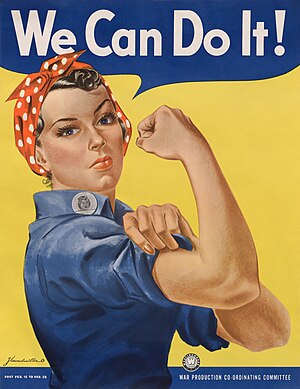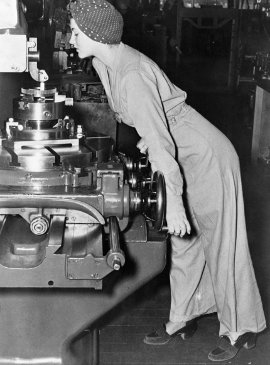Difference between revisions of "We Can Do It"
| Line 9: | Line 9: | ||
After its rediscovery, observers often assumed that the image was always used as a call to inspire women workers to join the war effort. However, during the war the image was strictly internal to Westinghouse, displayed only during February 1943, and was not for recruitment but to exhort already-hired women to work harder. People have seized upon the uplifting attitude and apparent message to remake the image into many different forms, including self empowerment, campaign promotion, advertising, and parodies. |
After its rediscovery, observers often assumed that the image was always used as a call to inspire women workers to join the war effort. However, during the war the image was strictly internal to Westinghouse, displayed only during February 1943, and was not for recruitment but to exhort already-hired women to work harder. People have seized upon the uplifting attitude and apparent message to remake the image into many different forms, including self empowerment, campaign promotion, advertising, and parodies. |
||
| − | It is unclear who is depicted on the poster. Until 2015 it was generally assumed to be Geraldine Hoff Doyle. Doyle saw the picture on the cover of Smithsonian Magazine in 1994, and said that she was the subject of the poster. Doyle thought that she had also been captured in a wartime photograph of a woman factory worker. Conflating her as "Rosie the Riveter", Doyle was honored by many organizations including the Michigan Women's Historical Center and Hall of Fame. Doyle only worked at the factory for two weeks before quitting. As a cellist she feared a hand injury which could impact here career.<ref>https://www.latimes.com/local/obituaries/la-me-geraldine-hoff-doyle-20101231-story.html</ref> |
+ | It is unclear who is depicted on the poster. Until 2015 it was generally assumed to be Geraldine Hoff Doyle. Doyle saw the picture on the cover of Smithsonian Magazine in 1994, and said that she was the subject of the poster. Doyle thought that she had also been captured in a wartime photograph of a woman factory worker. Conflating her as "Rosie the Riveter", Doyle was honored by many organizations including the Michigan Women's Historical Center and Hall of Fame. Doyle only worked at the factory for two weeks before quitting. As a cellist she feared a hand injury which could impact here career.<ref>https://www.latimes.com/local/obituaries/la-me-geraldine-hoff-doyle-20101231-story.html</ref> Use of the poster's image as a symbol of female empowerment was mocked among [[anti-feminists]] once her short tenure at the factory came to light. |
In 2015 others claimed that the woman in the wartime photograph was then 20-year-old Naomi Parker, working in early 1942 before Doyle had graduated from high school. |
In 2015 others claimed that the woman in the wartime photograph was then 20-year-old Naomi Parker, working in early 1942 before Doyle had graduated from high school. |
||
Revision as of 04:46, 17 December 2022
We Can Do It is an American World War II wartime poster produced by J. Howard Miller in 1943 for Westinghouse Electric as an inspirational image to boost female worker morale.
The poster was little seen during World War II. It was rediscovered in the early 1980s and widely reproduced in many forms, often called "We Can Do It!" but also erroneously called Rosie the Riveter after the iconic figure of a female war production worker. The "We Can Do It!" image was used to promote feminism and other political issues beginning in the 1980s. The image made the cover of the Smithsonian magazine in 1994 and was fashioned into a US first-class mail stamp in 1999. It was incorporated in 2008 into campaign materials for several American politicians, and was reworked by an artist in 2010 to celebrate the first woman becoming prime minister of Australia. The poster is one of the ten most-requested images at the National Archives and Records Administration.
After its rediscovery, observers often assumed that the image was always used as a call to inspire women workers to join the war effort. However, during the war the image was strictly internal to Westinghouse, displayed only during February 1943, and was not for recruitment but to exhort already-hired women to work harder. People have seized upon the uplifting attitude and apparent message to remake the image into many different forms, including self empowerment, campaign promotion, advertising, and parodies.
It is unclear who is depicted on the poster. Until 2015 it was generally assumed to be Geraldine Hoff Doyle. Doyle saw the picture on the cover of Smithsonian Magazine in 1994, and said that she was the subject of the poster. Doyle thought that she had also been captured in a wartime photograph of a woman factory worker. Conflating her as "Rosie the Riveter", Doyle was honored by many organizations including the Michigan Women's Historical Center and Hall of Fame. Doyle only worked at the factory for two weeks before quitting. As a cellist she feared a hand injury which could impact here career.[1] Use of the poster's image as a symbol of female empowerment was mocked among anti-feminists once her short tenure at the factory came to light.
In 2015 others claimed that the woman in the wartime photograph was then 20-year-old Naomi Parker, working in early 1942 before Doyle had graduated from high school.
The woman in the picture could be Doyle, Parker or another woman.
This article contains information imported from the English Wikipedia. In most cases the page history will have details. If you need information on the importation and have difficulty obtaining it please contact the site administrators. Wikipedia shows a strong woke bias. Text copied over from Wikipedia can be corrected and improved.

